You can create effective cockroach repellents using common household items like boric acid mixed with sugar, which attracts roaches while disrupting their digestive systems. Essential oil sprays made with peppermint or tea tree oil repel cockroaches when applied to baseboards and entry points. Diatomaceous earth sprinkled along cracks damages their exoskeletons, while white vinegar and lemon juice sprays disrupt their pheromone trails. These natural solutions offer safer alternatives to chemical pesticides for thorough roach control.
Boric Acid and Sugar Mixture for Effective Cockroach Elimination
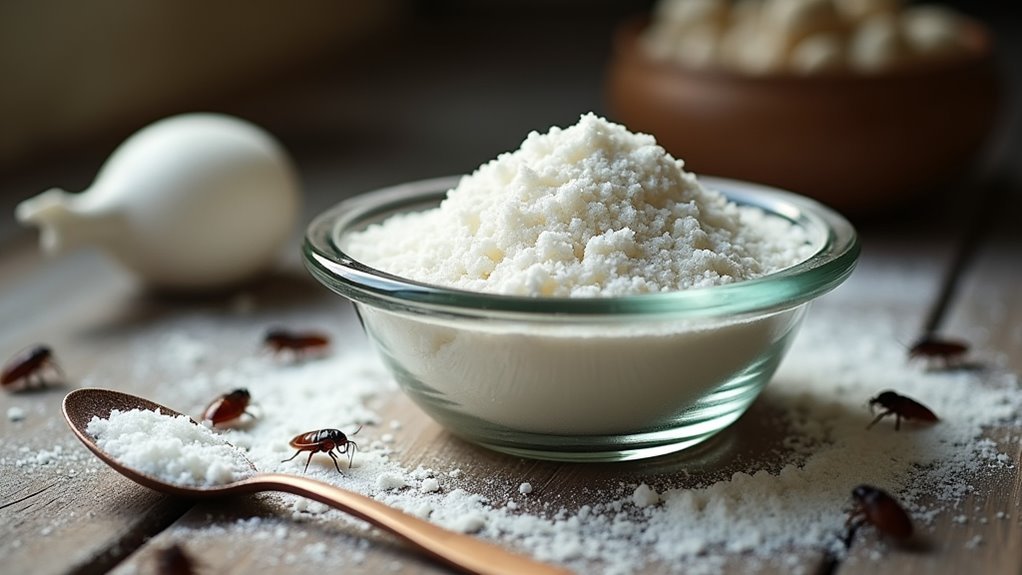
When you’re dealing with a persistent cockroach problem, the boric acid and sugar mixture stands out as one of the most effective homemade elimination methods available.
You’ll need equal parts boric acid and sugar to create this powerful cockroach elimination solution. The sugar acts as irresistible bait to attract roaches, while the boric acid serves as poison that disrupts their digestive systems upon consumption.
Combine equal parts boric acid and sugar to create an irresistible yet deadly bait that effectively eliminates cockroaches.
For maximum effectiveness, sprinkle this mixture in dry areas where moisture won’t compromise its potency. Focus on hidden spots like behind appliances, under sinks, and inside cracks where roaches typically hide.
Remember that boric acid is toxic, so keep it away from children and pets. This effective method continues working until the mixture becomes wet.
Baking Soda and Sugar Trap Using Common Household Items
If you’re looking for a safer alternative to boric acid, the baking soda and sugar trap offers an equally effective solution using items you already have in your kitchen. This mixture works by combining equal parts of both ingredients to create a lethal yet simple trap for cockroaches.
| Location | Why Effective | Refill Frequency |
|---|---|---|
| Under sinks | High moisture attracts roaches | Weekly |
| Kitchen cabinets | Food residue draws pests | Bi-weekly |
| Near trash bins | Odors lure cockroaches | Every 3 days |
| Behind appliances | Warmth and crumbs present | Weekly |
| Bathroom corners | Water sources attract insects | Bi-weekly |
The sugar will attract cockroaches while the baking soda disrupts their digestive system. Place your home-made trap in high-traffic areas and monitor regularly for maximum effectiveness against these persistent pests.
Essential Oil Sprays With Peppermint, Tea Tree, and Eucalyptus
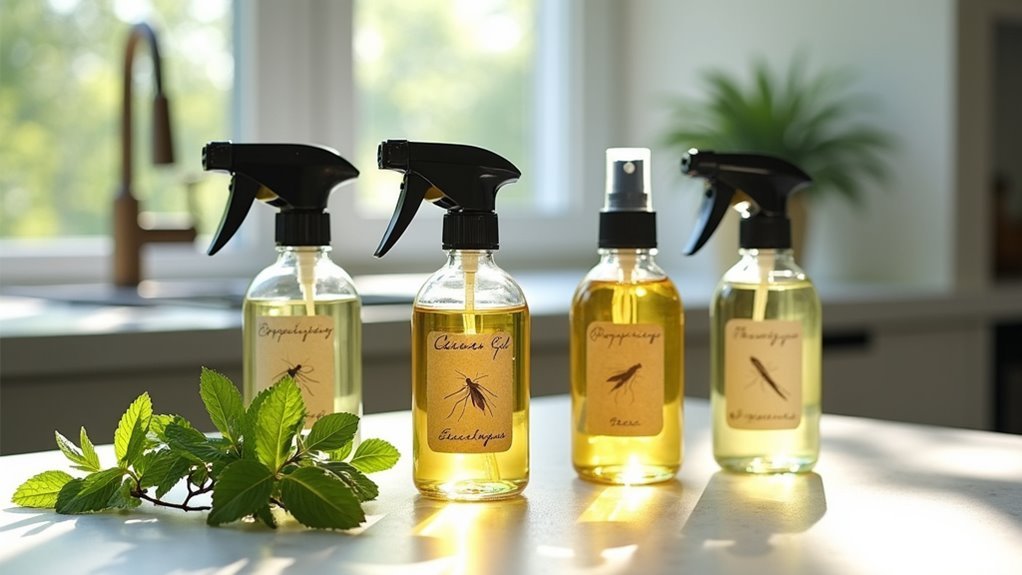
You’ll want to get your oil concentration ratios right when making essential oil sprays – typically mixing 1/4 cup of tea tree, peppermint, or eucalyptus oil with 2 cups of water creates an effective repellent.
Apply these sprays by targeting baseboards, entry points, and areas where you’ve spotted roach activity, reapplying every few days for best results.
While these natural oils are generally safe around pets and humans, you should still keep concentrated oils away from curious animals and test small areas first.
Oil Concentration Ratios
Since different essential oils require varying concentrations to effectively repel cockroaches, you’ll need to adjust your ratios based on the specific oil you’re using.
Getting these proportions right guarantees your natural cockroach repellent works effectively while remaining safe for household use.
Here are the best concentration ratios for each essential oil:
- Peppermint oil spray: Mix 10-15 drops with 2 cups of water for a potent yet gentle DIY solution.
- Tea tree oil solution: Combine 1/4 cup with 2 cups of water, creating the strongest concentration due to its antimicrobial properties.
- Eucalyptus oil: Use a 5-10% dilution in water for effective deterrence with pleasant scent.
Apply in areas where roaches frequent, focusing on kitchens and bathrooms where these pests commonly hide.
Application Methods Explained
Proper application technique determines whether your essential oil spray successfully repels cockroaches or simply wastes your homemade mixture.
Start by mixing 1/4 cup of peppermint or tea tree oil with 2 cups of water in your spray bottle. Shake thoroughly before each use to guarantee proper oil distribution.
Focus your DIY application methods on high-activity areas like kitchen counters, baseboards, and entry points where cockroaches typically travel. Spray directly onto surfaces, creating a barrier that’ll effectively repel cockroaches through scent deterrence.
Don’t oversaturate areas—light, even coverage works best.
Reapply your essential oil sprays every few days or immediately after cleaning these surfaces. Moisture and regular cleaning reduce effectiveness, so consistent reapplication maintains the protective barrier against future infestations.
Pet Safety Considerations
While essential oil cockroach repellents offer a natural pest control solution, they can pose serious health risks to your furry family members if you don’t use them properly.
Pet safety considerations are vital when implementing these natural alternatives.
Here are three essential guidelines for safe application:
1. Dilution is critical – Always guarantee peppermint oil, tea tree oil, and eucalyptus oil are properly diluted before use.
Tea tree oil requires extra caution around cats and dogs.
2. Test before widespread use – Create a small patch test in pet-accessible areas to monitor for adverse reactions before applying your repellent throughout the home.
3. Monitor pet behavior – Watch for signs of irritation, breathing difficulties, or unusual behavior after introducing any essential oils into your pest control routine.
Diatomaceous Earth Application for Natural Roach Control
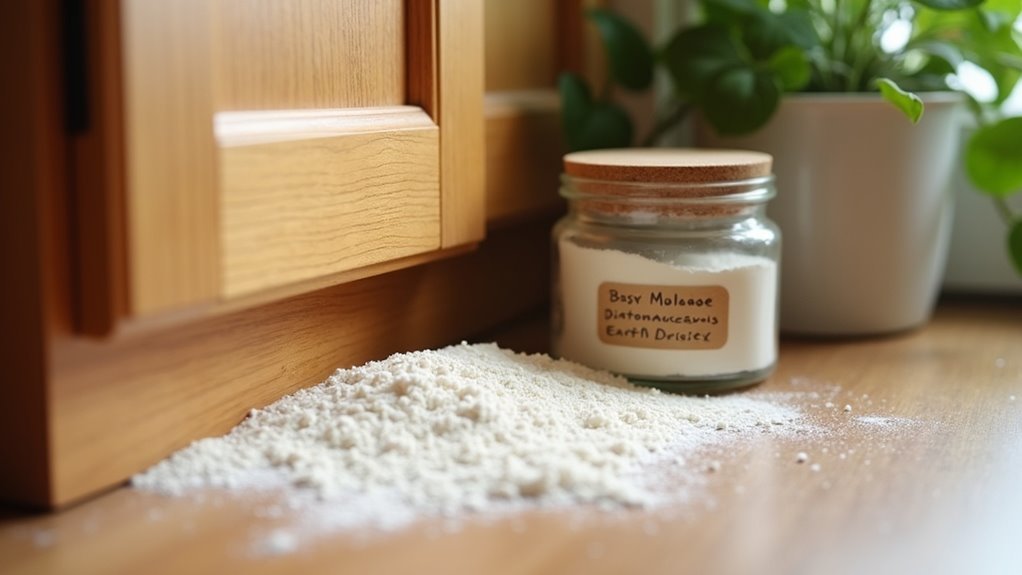
When you’re seeking a natural solution that won’t endanger your family or pets, diatomaceous earth stands out as one of the most effective cockroach repellents available. This non-toxic powder works by damaging roaches’ exoskeletons, causing fatal dehydration upon contact.
For proper application, lightly sprinkle DE along baseboards, cracks, and entry points where you’ve spotted cockroach activity. The powder must stay dry to maintain effectiveness in your indoor environment.
| Application Area | Method |
|---|---|
| Baseboards | Light dusting along edges |
| Cracks/Crevices | Targeted sprinkling |
| Entry Points | Barrier placement |
Reapply regularly in high-moisture areas, as dampness reduces control effectiveness. Combine diatomaceous earth with proper sanitation—seal food sources and eliminate standing water—to create an inhospitable environment that maximizes your roach elimination efforts.
White Vinegar and Lemon Juice Spray Solutions
You can create powerful cockroach repellents using two common household ingredients that pack a punch against these unwanted pests. White vinegar’s strong acidic properties make it an excellent foundation for spray solutions that roaches can’t stand. Lemon juice works similarly, creating barrier treatments that not only repel cockroaches but also leave your surfaces clean and fresh-smelling.
White Vinegar Spray Method
Since cockroaches rely heavily on pheromone trails to navigate and communicate, white vinegar disrupts these chemical signals and creates an effective natural barrier.
You’ll need to mix equal parts white vinegar and water to create this powerful repellent spray that targets infested areas effectively.
To maximize your solution’s potency, follow these steps:
- Combine equal parts white vinegar and water in a spray bottle for the base mixture
- Add fresh lemon juice to enhance the repellent properties with citric acid
- Apply regularly on surfaces where cockroaches commonly crawl to maintain the barrier
This spray method works by overwhelming cockroaches’ ability to detect food sources and navigate through your home.
The strong scent creates an inhospitable environment that forces these pests to seek shelter elsewhere.
Lemon Juice Barrier Solution
Building on the vinegar spray foundation, lemon juice creates an even more potent cockroach deterrent when you harness its natural citric acid content.
Mix equal parts lemon juice and water to create this powerful repellent that doubles as a cleaning solution.
Apply this water solution by wiping down surfaces where cockroaches frequent, creating an effective barrier that disrupts their navigation. The citric acid’s strong scent makes areas less inviting while sanitizing your home simultaneously.
You’ll notice the fresh, clean fragrance that replaces any musty odors cockroaches might follow.
This non-toxic approach proves especially valuable for households with children and pets, offering a safe alternative to harsh chemicals.
Regular application maintains the barrier’s effectiveness, keeping your space consistently protected from unwanted roach invasions.
Garlic, Onion, and Pepper Repellent Mixture
When cockroaches invade your home, a potent garlic, onion, and pepper repellent mixture offers an effective natural repellent solution that’ll send these unwanted pests packing.
This eco-friendly alternative creates a powerful spray that disrupts cockroaches’ ability to locate food sources through its pungent aroma.
The mixture works by:
- Extracting strong scents – Boiling garlic, onion, and pepper in water releases their most potent aromas that cockroaches find unbearable.
- Creating inhospitable environments – The powerful smell makes treated areas unattractive to roaches seeking food and shelter.
- Providing safe pest control – Unlike chemical pesticides, this spray won’t harm humans or pets while effectively reducing cockroach presence.
Apply this mixture regularly in problem areas to maintain a roach-free environment alongside proper cleanliness practices.
Bay Leaves and Cedar Wood Natural Deterrents
Nature provides two powerful allies in your battle against cockroaches: bay leaves and cedar wood. These natural deterrents work by releasing strong scents that repel cockroaches effectively.
Harness nature’s power with bay leaves and cedar wood—two natural cockroach deterrents that use strong scents to keep pests away.
You’ll want to crush bay leaves and scatter them in areas where roaches frequently appear. Cedar wood chips or blocks should be placed near hiding spots and entry points where their natural aroma creates an unwelcome environment for pests.
Both options are completely non-toxic, making them safe around children and pets. For enhanced protection against infestations, you can create spray mixtures using cedar oil for concentrated repellent effects.
While scientific evidence for bay leaves remains limited, anecdotal reports suggest they’re effective deterrents when properly crushed and strategically positioned throughout your home.
Soap and Water Contact Spray Method
While natural deterrents like bay leaves and cedar wood help keep cockroaches away, you’ll sometimes need immediate action against roaches you can see crawling around your home.
The soap and water contact spray method provides an effective solution for killing cockroaches on contact. This pest control technique works by coating their exoskeletons and blocking their breathing pores, suffocating them instantly.
Create your contact spray using this simple process:
- Mix the solution – Combine 1-2 tablespoons of liquid soap with one spray bottle of water
- Target visible cockroaches – Spray directly onto roaches in high-traffic areas for maximum effectiveness
- Apply liberally – Guarantee complete coverage to block all breathing pores
This method’s perfect for indoor use since it’s safe around pets and children while remaining inexpensive and residue-free.
Neem Oil and Mint Oil Barrier Treatment
Beyond immediate contact elimination, you’ll want to establish long-term protection against future cockroach invasions using neem oil and mint oil barrier treatments.
This natural repellent combines two powerful ingredients that cockroaches despise. Neem oil contains azadirachtin, which disrupts the hormonal system of these pests, while mint oil’s strong aroma creates an unpleasant environment they avoid.
Create your spray solution by mixing 2 tablespoons of neem oil and 10-15 drops of mint oil with 2 cups of water in a spray bottle.
Apply this mixture to cracks, crevices, and entry points where cockroaches typically travel. This treatment will effectively deter them from establishing territories in your home while remaining safe for indoor use around humans and pets.
Frequently Asked Questions
What Is the Best Homemade Roach Repellent?
You’ll find boric acid mixed with sugar works best as a homemade roach repellent. The sugar attracts cockroaches while boric acid poisons them upon contact, effectively eliminating the infestation at its source.
What Smell Do Roaches Hate the Most?
You’ll find roaches hate mint oil’s smell the most since it disrupts their natural behavior effectively. Essential oils like eucalyptus and tea tree also repel them strongly through their unpleasant aromas.
What Home Remedy Keeps Roaches Away?
You can sprinkle baking soda mixed with sugar in roach-prone areas, spray essential oil solutions around your home, or scatter garlic and cayenne powder where they typically travel.
What Is a Homemade Recipe for Getting Rid of Cockroaches?
You can mix three parts boric acid with one part sugar to create an effective cockroach killer. Place this mixture in areas where you’ve seen roaches to attract and poison them.
In Summary
You’ve got nine proven methods to eliminate cockroaches without harsh chemicals. Don’t wait for an infestation to worsen—start with the boric acid mixture for quick results, then establish barriers using essential oils or diatomaceous earth. Rotate between different repellents to prevent roaches from adapting. Remember, consistency’s key—reapply treatments regularly and maintain a clean environment. You’ll see fewer roaches within days and complete elimination with persistent use.

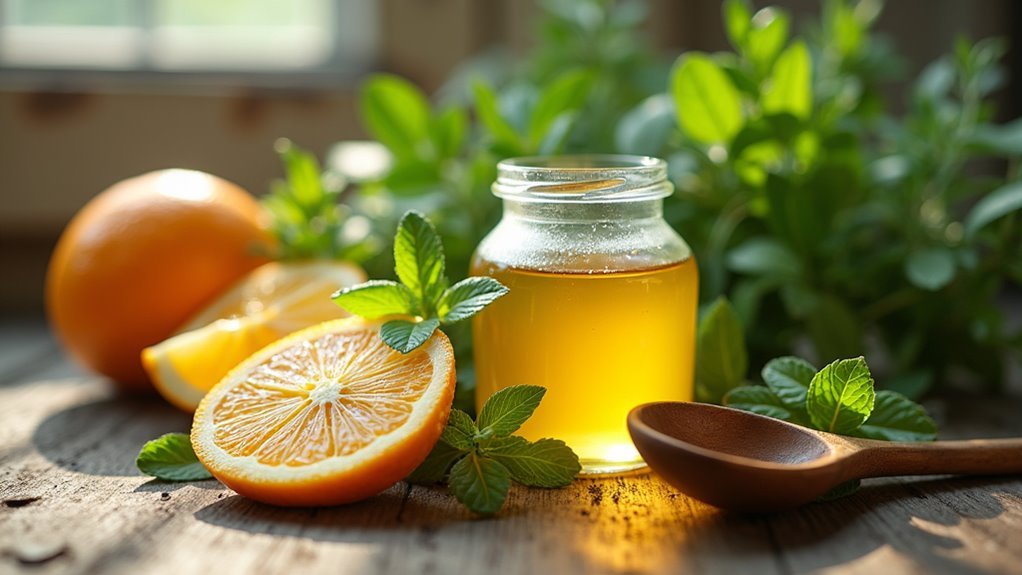
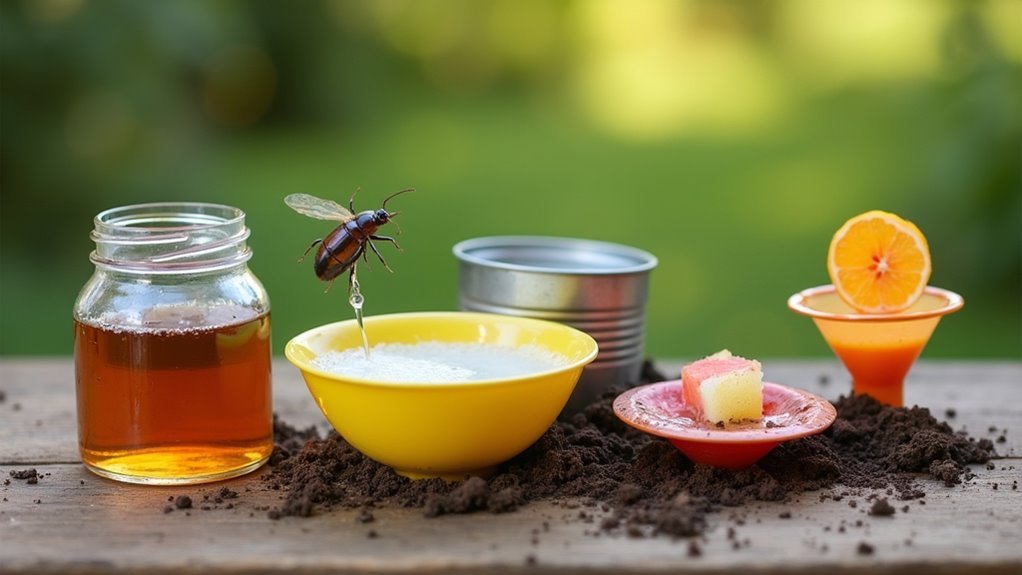


Leave a Reply